Ice campaign of the Russian army
The campaign plan of the Russian army for 1809 year included the seizure of the Aland Islands, the invasion of the Swedish kingdom from three directions, the occupation of Stockholm and the forcing of the enemy to peace on the terms of Russia. To this end, by the beginning of the hostilities, three detachments were formed: 1) The southern corps under the command of P.I. Bagration (according to various sources about 15 - 18 thousand people with 20 guns); 2) Medium Corps under the authority of M. B. Barclay de Tolly (3,5 thousand people with 8 guns); 3) Northern Corps under the command of P. A. Shuvalov (about 4 - 5 thousand people with 8 guns).
The commander-in-chief of the Russian army in Finland, General BF Knorring, believed that this plan could not be realized. Therefore, in every way delayed the beginning of the offensive. Hoping that with the beginning of the melting of the ice in the Gulf of Bothnia, it will be abandoned. However, under the pressure of the Minister of War A. A. Arakcheev was forced to launch an offensive. Bagration Corps made 26 February (10 March) 1809 of the year from Abo (Finland) and, crossing the ice of the Gulf of Bothnia, went to the Aland Islands. Suppressing weak resistance 6-th. of the Swedish garrison of General G. Debeln; the Russian troops of 6 (18) of March occupied the archipelago, capturing 2 of thousands of people prisoners, 32 guns and about 150 ships ice-bound. In pursuit of the retreating Swedes, the Russian 1-thousand. under the command of General J.P. Kulnev, the forward detachment entered March 7 (19) on the Swedish coast, captured the town of Grislehamn (Hargshamn). Thus, the Russian army created a threat to the Swedish capital. In Stockholm, panic began.
The troops of Barclay de Tolly, crossing the ice on the Kvarken Strait (connecting the northern and southern parts of the Gulf of Bothnia), 12 (24) in March occupied the city of Umeå. The northern corps of Shuvalov, advancing along the coast, occupied Tornio (Tornio) without a fight, and 13 (25) of March captured Kalix. Our troops bypassed the 7-thousand defended here. the Swedish corps of General Grippenberg, the enemy capitulated.
Meanwhile, in the Swedish capital 1 (13) in March 1809, King Gustav IV Adolf was overthrown. The conspiracy was led by the military, dissatisfied with the policies of the king, which led to the economic and military crisis. The regent, the duke Karl of Södermanland (the future king Charles XIII) asked the Russian armistice for the armistice. General Knorring, who feared that the opening of the ice would lead to the blockade of the Russian army in Sweden and its defeat, accepted this proposal. Although there was a strategic opportunity to complete the rout of Sweden. 20 -25 March 1809, the troops of Bagration retreated to their original positions. A small garrison was left on the Aland Islands.
Soon, Alexander, the Tsar, who arrived in Finland, canceled the truce. The fighting was continued. Knorring was replaced by Barclay de Tolly. Shuvalov's squad occupied Umeå. The new Swedish government decided to continue the fighting and repel Ostrobothnia (Ostrobothnia - the middle part of Finland). However, the Swedes could not change the course of the war and organize a partisan war in Finland occupied by the Russian army. In September 1809, Sweden signed peace, giving way to Finland and the Aland Islands to the Russian Empire.
Thus, the March 1809 Ice Campaign of the year, although it did not reach the goal, but ultimately predetermined the outcome of the war. 5 (17) September 1809, war-drained Sweden signed a peace treaty in Friedrichsgame.
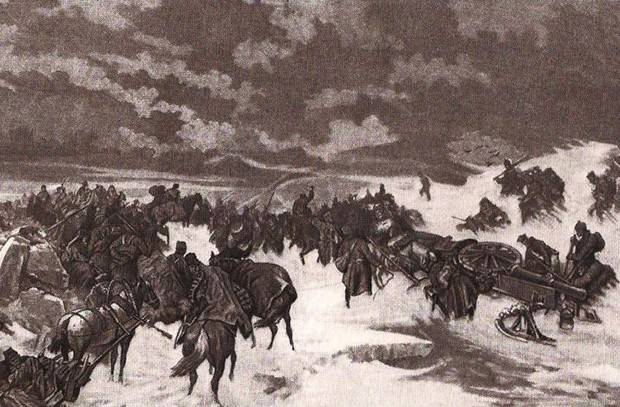
"The transition of Russian troops through the Gulf of Bothnia in March 1809 of the year." Woodcut of L. Veselovsky, K. Kryzhanovsky by the original A. Kotzebue 1870
Russian-Swedish war
Sweden was the old enemy of Russia. The great Russian princes, Novgorod, Muscovy and the Russian Empire fought the Swedes. The military-strategic and economic interests of Sweden and Russia collided in the Baltic States and Finland. In the course of the weakening of the Russian state, the Swedes were able to occupy the Russian sphere of influence in Finland and the Baltic states, the Russian northwestern lands.
Peter the First during the long Northern War of 1700 - 1721 returned the previously lost cities and territories - part of Karelia, Izhora land (Ingermanland), Estonia and Livonia. During the wars of 1741 - 1743. and 1788 - 1790 Sweden tried to take revenge, but was defeated. At the beginning of the XIX century, Stockholm still hoped to take revenge and regain at least part of the lost territories. The Swedish kingdom at that time remained one of the most powerful European powers with a strong army and fleet. Sweden had a developed industry, was the main center of European metallurgy.
Initially, Russia and Sweden were allies in the fight against Napoleonic France. However, Alexander I was defeated in the fight against Napoleon, and in 1807, Russia and France became allies, concluding the Tilsit agreement. Russia joined the continental blockade of England, the main enemy of France. The British attacked a Russian ally - Denmark. Russia and England were in a state of sluggish war (there is no common border for active confrontation). Petersburg demanded the support of Sweden - on the basis of the previous agreement to close the Baltic Sea to the British, Gustav IV rejected these demands and headed for rapprochement with London. The British promised the Swedes help in the fight against Russia - money and a fleet. In addition, the Swedes were going to win Norway from Denmark, and the Danes were allies of Russia. As a result, Petersburg decided to start a war with Sweden in order to protect the capital from the long-standing threat from the north. In turn, Napoleon promised Russia full support, even if Alexander wished to take over all of Sweden.
The fighting began in February 1808. An unfavorable circumstance for Russia was the fact that Petersburg did not want to concentrate a serious army against Sweden. The Russian army at that time was at war with the Ottoman Empire. In addition, Petersburg was still secretly considered Napoleon’s empire to be the main enemy, and the main and best forces of the Russian Empire stood in the western strategic direction. Therefore, at the beginning of the war, the Russian army numbered only 24 thousand people against 19 thousand Swedes. In this case, to rely on a serious gain was not necessary. The Russian fleet in the Baltic was weak in composition and quality, it was launched, so there was also no hope for serious support from the sea.
In the spring of 1808, the Russian army took the main, strategic fortress of the Swedes - Sveaborg, with hundreds of guns, huge reserves and part of the Swedish fleet. During the 1808 campaign, the Russian army with stubborn battles occupied the whole of Finland. All the Swedish fortresses were captured, the Swedish landing troops repulsed. The main difficulty was the Finnish guerrilla war led by Swedish officers. However, the guerrillas won. Swedish troops retreated to the territory of Sweden itself. The English fleet could not have any influence on the land war.
Thus, during the 1808 campaign of the year, the Russian army captured Finland and all the Swedish fortresses there, including the largest base and the Swedish arsenal - Sveaborg. However, the Swedish army, retreating into the territory of the Swedish kingdom, retained combat capability. In winter, the Swedes had the opportunity to recuperate and continue the war with new forces. The Swedish fleet, with the support of English, was superior to the sea. Further offensive along the seashore was complicated by poor communications and problems in the supply of troops. It was clear that in the spring the rested and replenished Swedish army would try to regain Finland, and a partisan war would be organized again. The rugged bays of the Finnish coast stretched for many hundreds of miles, so it could not be safely covered from the Swedish troops. It was impossible to drag out the war, a new big war was brewing in Europe.
Ice Trip Plan
The Russian High Command, headed by Emperor Alexander, understood this well. Despite the conquest of Finland, the enemy army remained operational and in the spring of 1809, the struggle was to start again. The war dragged on. It was very dangerous. The war with the Swedes had to end as quickly as possible, with a decisive blow. Thus was born the idea of moving Russian troops across the ice of the frozen Baltic Sea, in order to capture Åland and strike at the heart of Sweden. Forcing the enemy to admit defeat.
The plan was decisive and bold. The huge Gulf of Bothnia between Finland and Sweden was at times covered with ice. But at any moment there could be a thaw. There have been winter storms in the Baltic that would easily break the ice and destroy the troops. It was necessary to go around 100 versts on unreliable sea ice to meet a strong enemy. At the same time it was not even ice of frozen rivers and lakes. Sea storms often broke ice shells, then frost again fettered debris. It turned out whole ice mountains, impassable hummocks, in which it was necessary to look for a new path. In ice there were huge openings and cracks, they could be covered with snow.
In addition, there was a danger that storms or thaws would destroy the ice immediately after a successful transition, and our army would be cut off from reinforcements and without supplies. The fleet in such a situation could not yet assist the ground forces. The author of this plan, apparently, was a young talented General Nikolai Kamensky, who distinguished himself in the battles for Finland in the 1808 year. At the end of 1808, Kamensky fell ill and left the Finnish front. In 1810, he will lead the Danube army and inflict a number of heavy defeats on the Turks. However, in 1811, a fever will kill him.
The commander-in-chief of the Russian army in Finland was then Count Fedor Fyodorovich Buksgevden (Friedrich Wilhelm von Bukskhoveden. He was of German German origin. He was a brave and skillful commander, he fought with the Turks, Swedes, beat the Poles under Suvorov. He fought for anti-France forces. and 1805-1806 commanded the Russian army in the war with Sweden and during the 1807 campaign of the year his troops took control of the whole of Finland. However, in Petersburg, Buxgevden was considered too careful. He did not dare to lead the army on ice y, everything at any moment could end in a catastrophe: "The battalions are not frigates to walk in the bays ...".
Emperor Alexander appointed a new commander - Bogdan Fedorovich Knorring, also from the Baltic German nobles. He also had a great military experience, fought with the Turks, Poles and French. However, Knorring, considering the army’s campaign plan on the ice of the Gulf of Bothnia too risky and not having the will to directly oppose the plan of St. Petersburg, in every way delayed the start of the operation under the pretext of lack of proper preparation and necessary supplies. He did not want to take risks that could not be calculated. Knorring waited, hoping that with the melting of ice, the plan could be abandoned.
So the commander-in-chief Knorring was dragging all winter. Finally, in February 1809, he admitted that he was not ready for the Ice Campaign and asked for his resignation. The winter was ending, and the war threatened to become protracted. Then Alexander sent to the front of his favorite Alexei Arakcheev. About him, the liberals created a “black myth” about a stupid soldier, a negative and reactionary persecutor of the foremost, “baton” king. Indeed, it was a decisive and tough statesman, a talented manager and artilleryman who created such artillery for the 1812 war of the year, which did not step in French or even surpassed it.
Arakcheev received unlimited power in Finland. At the meeting in Abo all the commanders spoke about the complexity and the huge risk of the operation. Only Bagration decisively said: "... order us to go!" Arakcheev decided to go. By his efforts the troops were equipped with everything necessary. In particular, the troops received winter clothing - fur hats, sheepskin coats, sheepskin sleeveless jackets for overcoats and felt boots. It was impossible to burn fires on the ice for cooking, so the soldiers were provided with portions of lard and flasks of vodka. Horses perepovali new winter horseshoes, guns put on a winter sled.
The Russian troops in Finland were divided into three detachment-corps under the command of Shuvalov, Barclay de Tolly and Bagration. The northern corps of Shuvalov was to advance along the seashore from the area of the city of Uleaborg to the city of Tornio (Tornio) and further to the west and south to the city of Umeo. The middle building of Barclay de Tolly received the task of walking from the city of Vasa (Vaza) on the coast of Finland on Umeå on the ice of the Quarken, only about 90 vers. The main blow was inflicted by the forces of the Southern Corps of Bagration. Our troops were to go from the region of Abo across the ice of the Gulf of Bothnia to go around the 90 versts, capture Aland and then go across the ice about 40 versts and reach the Stockholm area. In the cold and blizzard, the soldiers of Bagration had to overcome the icy expanses of the Gulf of Bothnia, break up the strong Swedish garrison on the Alands, occupy the fortified islands, go to the Swedish coast and gain a foothold there.
Bagration Corps numbered about 17 thousand people: 30 infantry battalions, 4 squadron of cavalry, 600 Cossacks and 20 guns. The Swedish corps in Åland counted 6 thousand regular troops and 4 thousand local militia. The islands were prepared for defense. All the inhabitants of the islands located between Finland and Greater Aland (the largest island of the archipelago were evicted, villages burned, supplies destroyed.
Trekking
At the end of February 1809, the Bagration detachment from the Abo area moved to the starting point on the island of Kumlinge. 3 (15) March 1809, the Russian troops began their amazing march. Moving troops 5 columns. At the head of the columns were avant-gardes. The columns were followed by two reserves. By developing a swift offensive from the front and simultaneously bypassing the Swedish corps from the south, the Russians created a threat to the enemy’s environment. Fearing the blockade and the fact that the spring began to cut them off from Sweden, the Swedes refused to stubborn defense and ran. Already 6 (18) in March, Bagration’s detachment captured Åland, taking more than 2 thousand prisoners and serious trophies (including part of the Swedish fleet that wintered here). The advanced detachment of Major General Kulnev pursued the enemy. The Russian 7 (19) of March reached the shores of Sweden and quickly captured the city of Grislehamn in 80 km from the Swedish capital. The news of the appearance of the Russians (“Russians are coming!”) Caused panic in Sweden.
Other Russian corps also operated successfully. The reinforcements did not have time to go to the north of Finland, therefore the Barclay de Tolly detachment numbered only about 3,5 thousand people. Russian warriors took to the ice of Kvarken Bay early in the morning of March 8. From the very beginning, Russian soldiers faced terrible difficulties. A few weeks ago, a strong storm broke the ice and piled up the icy mountains. Soldiers had to climb these obstacles or get them out of the way, and even in a blizzard. Horses, cannons and a wagon train with supplies had to be thrown, it was impossible to drag them through the icy rocks. A strong wind rose and people were afraid that this was a precursor of a new hurricane. Ahead of the way was the Don Cossacks of sergeant Dmitry Kiselev. After 12 hours of a grueling transition, at 6 hours of the evening the troops stopped to rest. To avoid the loss of people during an overnight stay on the ice, Barclay de Tolly decided not to stop for the night. After a halt, the troops went forward at midnight again. This transition lasted 18 hours. The last miles of soldiers had to go in deep snow. As Tsar Tolly wrote, "the work only the Russian carried in this transition can only be overcome." In the evening of March 9, Russian troops reached the Swedish coast. 12 (24) March, the troops of the Middle Corps captured Umeå. No one expected the Russians to attack here, the frozen Kvarken Strait was considered impassable.
Meanwhile, Shuvalov’s corps took Torneo. The situation has forced the Swedish government to request a truce. The Russian command, fearing the opening of the ice cover and the isolation of the advanced forces of Bagration and Barclay de Tolly, recalled the troops back. A garrison was left at Åland. Sweden, due to internal turmoil and military-economic exhaustion, soon went to the world. In the autumn of 1809, Finland became Russian, and Russia secured the northwest strategic direction.
Peter Bagration and Mikhail Barclay de Tolly, who commanded Ice Campaign on the Baltic Sea, unparalleled in world history, were rightly considered the best generals of the Russian Empire. Soon it was they who headed the two Russian armies, which took upon themselves the blow of Napoleon’s "Great Army".
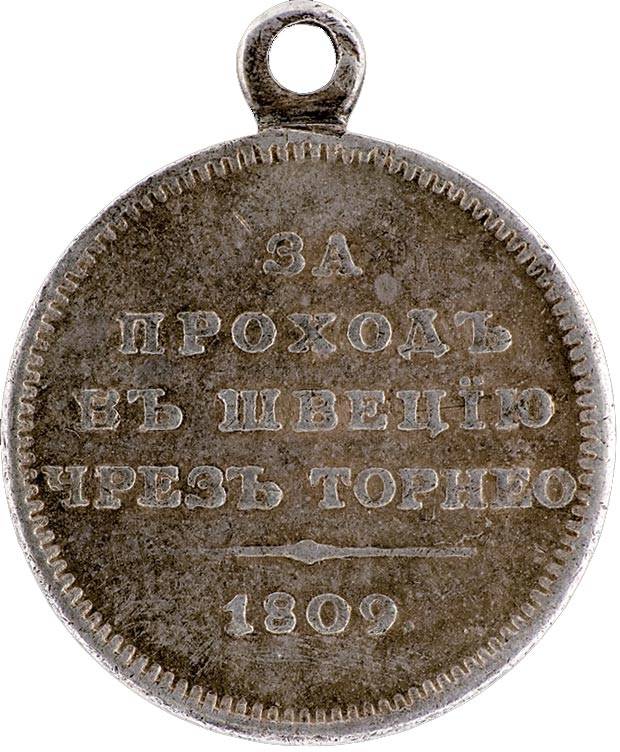
Medal "For the passage to Sweden through Tornio", reverse. It was established by Alexander I in April 1809 of the year due to the military successes of the Russian army during the Russian-Swedish war. The medal was awarded to the soldiers of the detachment of P. A. Shuvalov, the participants of the march to Sweden along the coast of the Gulf of Bothnia through the city of Tornio.
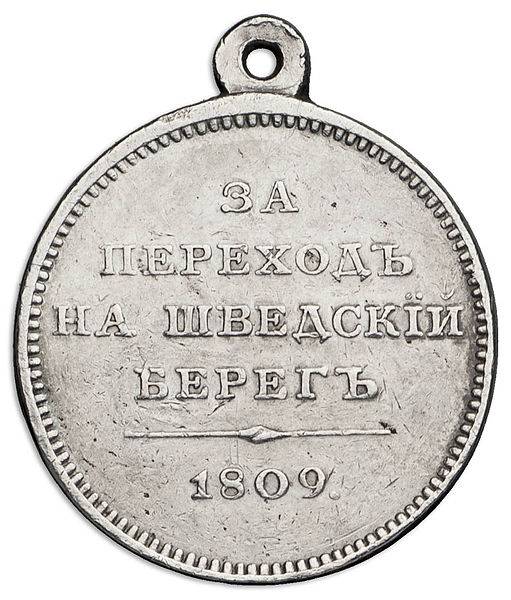
Medal "For the passage to the Swedish coast", reverse. She was awarded soldiers who participated in the transition to Sweden on the ice of the Gulf of Bothnia
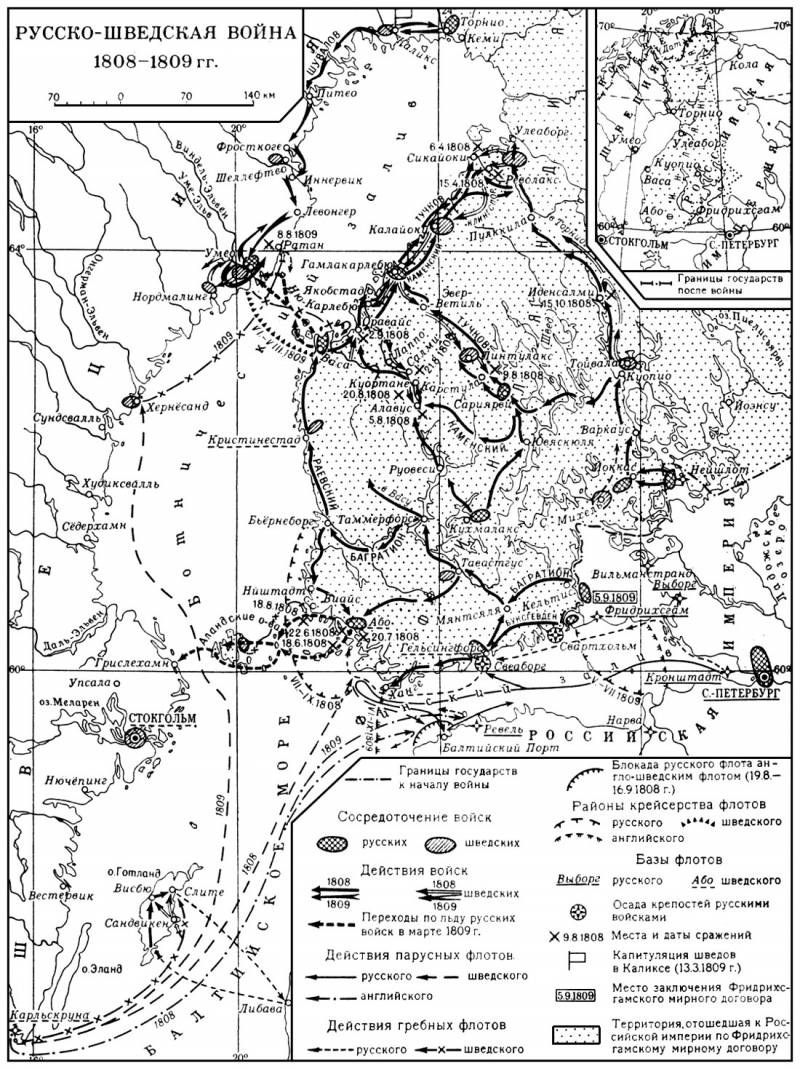
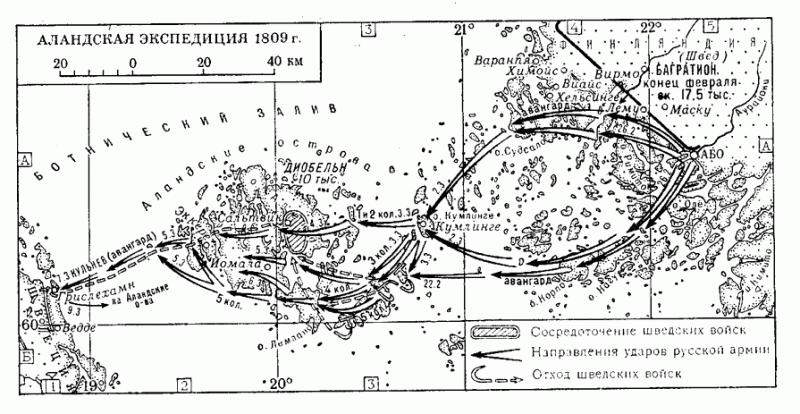
Information